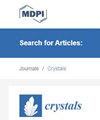Effect of Laser Heat Input on the Microstructures and Low-Cycle Fatigue Properties of Ti60 Laser Welded Joints
IF 2.4
4区 材料科学
Q2 CRYSTALLOGRAPHY
引用次数: 0
Abstract
In this paper, the effects of laser heat input on the microstructures, tensile strength, and fatigue properties of Ti60 laser welded joints were investigated. The results show that with the increase in laser heat input, the macro morphology of the weld zone (WZ) changes from the Y-type to X-type. In the Y-type WZ, the porosity defects are almost eliminated. In contrast, there are a lot of porosity defects in the lower part of the X-type WZ. The microstructure of the base metal (BM) comprises equiaxed α phases, and β phases are mainly distributed at the boundaries of α phases. The heat-affected zone (HAZ) is comprised of α phases and acicular α′ phases, while the WZ mainly contains acicular α′ phases. With the increase in laser heat input, the quantity of the α phase gradually decreases and the acicular α′ phase gradually increases in the HAZ, and the size of the acicular α′ phase in the WZ gradually decreases. Due to the different microstructures, the hardness of BM is lower than the HAZ and WZ under different laser heat input conditions. In the tensile tests and low-cycle fatigue tests, the welded joints are fractured in BM. The porosity defects do not have decisive effects on the tensile and low-cycle fatigue properties of Ti60 laser welded joints.激光热输入对 Ti60 激光焊接接头微观结构和低循环疲劳性能的影响
本文研究了激光热输入对 Ti60 激光焊接接头的微观结构、拉伸强度和疲劳性能的影响。结果表明,随着激光热输入的增加,焊接区(WZ)的宏观形态从 Y 型变为 X 型。在 Y 型 WZ 中,气孔缺陷几乎消除。相反,在 X 型 WZ 的下部则存在大量气孔缺陷。基体金属(BM)的微观结构由等轴的α相组成,β相主要分布在α相的边界。热影响区(HAZ)由 α 相和针状 α′ 相组成,而 WZ 主要包含针状 α′ 相。随着激光输入热量的增加,HAZ 中 α 相的数量逐渐减少,针状 α′ 相逐渐增加,而 WZ 中针状 α′ 相的尺寸逐渐减小。由于微观结构不同,在不同的激光热输入条件下,BM 的硬度低于 HAZ 和 WZ。在拉伸试验和低循环疲劳试验中,焊接接头在 BM 中断裂。气孔缺陷对 Ti60 激光焊接接头的拉伸和低循环疲劳性能没有决定性影响。
本文章由计算机程序翻译,如有差异,请以英文原文为准。
求助全文
约1分钟内获得全文
求助全文
来源期刊

Crystals
CRYSTALLOGRAPHYMATERIALS SCIENCE, MULTIDIS-MATERIALS SCIENCE, MULTIDISCIPLINARY
CiteScore
4.20
自引率
11.10%
发文量
1527
审稿时长
16.12 days
期刊介绍:
Crystals (ISSN 2073-4352) is an open access journal that covers all aspects of crystalline material research. Crystals can act as a reference, and as a publication resource, to the community. It publishes reviews, regular research articles, and short communications. Our aim is to encourage scientists to publish their experimental and theoretical results in as much detail as possible. Therefore, there is no restriction on article length. Full experimental details must be provided to enable the results to be reproduced. Crystals provides a forum for the advancement of our understanding of the nucleation, growth, processing, and characterization of crystalline materials. Their mechanical, chemical, electronic, magnetic, and optical properties, and their diverse applications, are all considered to be of importance.
 求助内容:
求助内容: 应助结果提醒方式:
应助结果提醒方式:


